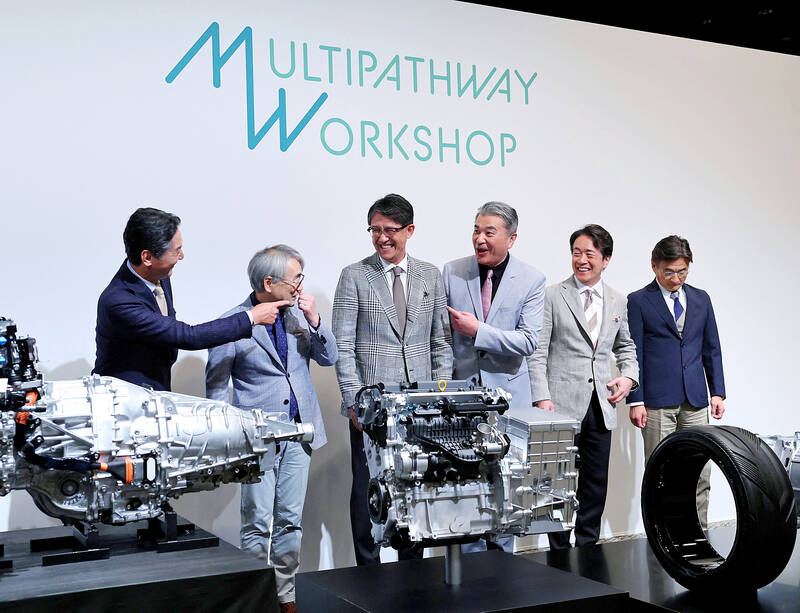Toyota Motor Corp yesterday showcased next-generation engines that can be used in vehicles as varied as hybrids and those running on biofuel, as it targets tougher emissions standards and doubles down on its strategy of selling more than just electric vehicles (EVs).
At a media event with peers Subaru Corp and Mazda Motor Corp, the world’s biggest automaker by volume displayed in-development 1.5-liter and 2-liter engines with significantly reduced volume and height compared with current engines.
“With these engines, each of the three companies will aim to optimize integration with motors, batteries and other electric drive units,” they said in a joint statement.

Photo: Reuters
Toyota owns about one-fifth of Subaru and about 5 percent of Mazda.
The three said their efforts would help decarbonize internal combustion engines by making them compatible with alternative fuel sources such as e-fuels and biofuels.
They also hope more compact engines would revamp vehicle design by allowing for lower hoods.
Toyota is widely considered an EV laggard, but a slowdown in EV growth has seen it benefit from an uptake of gasoline-electric hybrids. Refreshing its traditional engine technology against that backdrop mirrors a similar move at Mercedes-Benz AG.
The Japanese automaker said its new 1.5-liter engine would achieve volume and weight reduction of 10 percent versus its existing 1.5-liter engines, which it uses in vehicles such as its Yaris compact.
The new 2-liter turbo engine would have similar gains versus existing 2.4-liter turbo engines used in bigger models such as three-row seating sport utility vehicles.
Toyota chief technology officer Hiroki Nakajima declined to say when the company would launch models equipped with the engines.
While EVs have become more prominent in the past few years, Toyota has been following a “multi-pathway” approach to carbon neutrality with vehicles offering a range of powertrains.
It sold about 2.4 million vehicles in the January-to-March period, of which nearly two-fifths were gasoline-electric hybrids. Plug-in hybrid, fuel-cell and all-battery electric vehicles together accounted for just 2.9 percent.
Toyota chairman Akio Toyoda in January said EVs would reach a global auto market share of 30 percent at most, with hybrids, hydrogen fuel-cell and fuel-burning vehicles making up the rest.

TARIFF TRADE-OFF: Machinery exports to China dropped after Beijing ended its tariff reductions in June, while potential new tariffs fueled ‘front-loaded’ orders to the US The nation’s machinery exports to the US amounted to US$7.19 billion last year, surpassing the US$6.86 billion to China to become the largest export destination for the local machinery industry, the Taiwan Association of Machinery Industry (TAMI, 台灣機械公會) said in a report on Jan. 10. It came as some manufacturers brought forward or “front-loaded” US-bound shipments as required by customers ahead of potential tariffs imposed by the new US administration, the association said. During his campaign, US president-elect Donald Trump threatened tariffs of as high as 60 percent on Chinese goods and 10 percent to 20 percent on imports from other countries.

Taiwanese manufacturers have a chance to play a key role in the humanoid robot supply chain, Tongtai Machine and Tool Co (東台精機) chairman Yen Jui-hsiung (嚴瑞雄) said yesterday. That is because Taiwanese companies are capable of making key parts needed for humanoid robots to move, such as harmonic drives and planetary gearboxes, Yen said. This ability to produce these key elements could help Taiwanese manufacturers “become part of the US supply chain,” he added. Yen made the remarks a day after Nvidia Corp cofounder and chief executive officer Jensen Huang (黃仁勳) said his company and Taiwan Semiconductor Manufacturing Co (TSMC, 台積電) are jointly

United Microelectronics Corp (UMC, 聯電) expects its addressable market to grow by a low single-digit percentage this year, lower than the overall foundry industry’s 15 percent expansion and the global semiconductor industry’s 10 percent growth, the contract chipmaker said yesterday after reporting the worst profit in four-and-a-half years in the fourth quarter of last year. Growth would be fueled by demand for artificial intelligence (AI) servers, a moderate recovery in consumer electronics and an increase in semiconductor content, UMC said. “UMC’s goal is to outgrow our addressable market while maintaining our structural profitability,” UMC copresident Jason Wang (王石) told an online earnings

MARKET SHIFTS: Exports to the US soared more than 120 percent to almost one quarter, while ASEAN has steadily increased to 18.5 percent on rising tech sales The proportion of Taiwan’s exports directed to China, including Hong Kong, declined by more than 12 percentage points last year compared with its peak in 2020, the Ministry of Finance said on Thursday last week. The decrease reflects the ongoing restructuring of global supply chains, driven by escalating trade tensions between Beijing and Washington. Data compiled by the ministry showed China and Hong Kong accounted for 31.7 percent of Taiwan’s total outbound sales last year, a drop of 12.2 percentage points from a high of 43.9 percent in 2020. In addition to increasing trade conflicts between China and the US, the ministry said